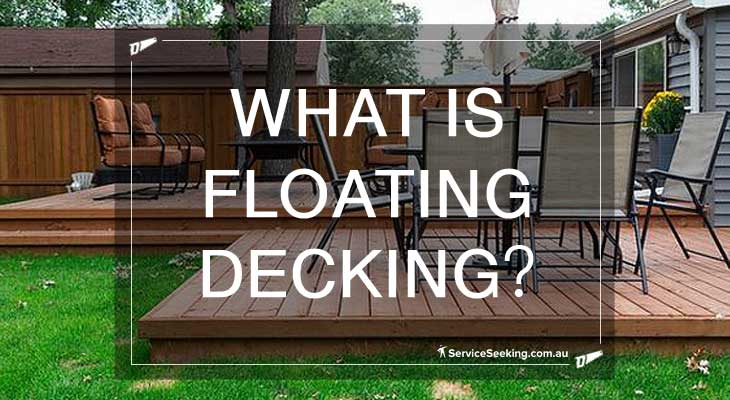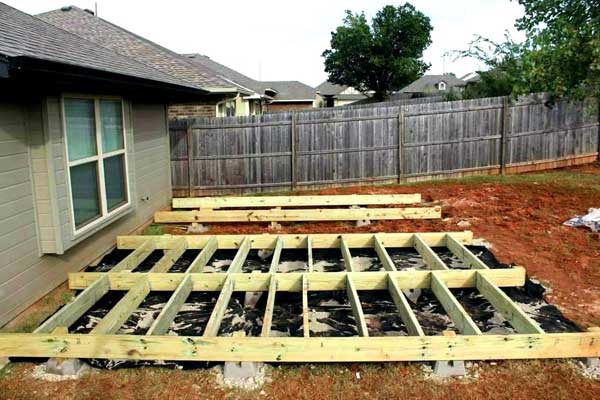What is floating decking?
Floating, platform and freestanding decking are the same thing. Learn what makes them different from other decking types and how to make one. Read more.

Floating decking is the type of decking that doesn’t lean on the house or any other vertical surface but stands on its own blocks, independently. That is why this type of decking seems like it is floating above the ground. It is also called freestanding or platform decking.
Floating decking can be a nice DIY project for experienced and versatile DIY masters. It involves working with timber and concrete. Also, there is a lot of precision work involved.
On the other hand, less-than-perfect floating decking will not cause big safety hazards, but it will cost you time and money that you don’t want to waste on a project that doesn’t give good results.
It is best to simply hire a professional decking installer. They will make your decking in no time, as this is not a difficult task for an experienced decking installer.
How to Build a Floating Desk?
First of all, you need to calculate how big of a deck you want. Is it just a sun deck for two chairs and a small table? Is this decking about to become your outdoor dining area? For how many people? Where do you want to place your decking?
Answers to these questions are important for your plans. Let’s say you have chosen the size of your decking. You need to get some string and attach it to small wooden stakes that you can put in the ground. By using these stakes and string, mark the area of your future decking.
Now that you know what area of your backyard your decking is about to occupy, you need to prepare it for further work. First of all, level the ground and destroy any weeds that grow there. If they are not destroyed, they will damage your decking.
Weeds attract insects, and they tend to grow through the decking timber. That is not something that you want if you wish for your decking to appear nice and tidy. You can prevent the weeds from growing again by laying the special canvas or even gravel on it.

Place the concrete blocks in all four corners of your future floating decking. Keep them in line and add other concrete blocks to the critical points. Use joists to make a grid, and then, finally, lay the decking of your choice over the joists.
If you are using timber for your decking, you need to make sure that the width of your joists is not more than four times its thickness. This is to avoid the cupping that can happen due to the increased moisture since the timber is so close to the ground.
How Far Apart Should Concrete Deck Blocks Be?
Generally, you want your joists to be around 45 cm apart. You don’t need a concrete block for every joist, but it is advisable to place them for every other joist or not more than 90 cm apart. On average, you can place a block every 60 cm, but they need to be in each of the four corners, and they need to support the middle bearer beam.
All your blocks need to be levelled, and they need to be perfectly in line. Otherwise, two things can happen. The first one is – your joist simply won’t be able to lay on all concrete blocks as they should. Secondly, you can manage to squeeze the joists into slightly uneven concrete blocks, but that means they will put up with the pressure constantly and that can damage your decking.
How High Should Decking Be Off the Ground?
There is no minimal height for your decking. If you want, you can place it directly on the ground, but in that case, you have to make sure that you are constructing it from the material that can sustain it. For example, if you are using timber, you will have to use decking timber Class 1. If you are using treated pine, it will have to be at least H4 or H5.
The main concern for very low decking is its ability to get enough ventilation. The construction needs to ‘breathe’. If you are using timber, make sure it has at least a 5 mm gap between the decking planks. Also, if the weeds are not permanently destroyed, you need to be able to clean the area underneath the decking.
Do I Need a Permit for a Floating Deck?
This depends on the size of your floating deck. Most likely, you will not need a permit for a floating deck that is not attached to your house or larger than 25 m2. However, while some councils don’t require a minimum height of a floating deck, some require your floating deck to be at least 400 mm from the ground if it is next to your house.
Therefore, it is best that you contact your local council and show them the plans for your decking. They will inform you if you need the permit and how much those possible permits cost. For general information, here are the websites of departments and agencies in different Australian states that deal with these building issues:
New South Wales
Queensland
Victoria
South Australia
Tasmania
How Much Does It Cost to Build a Floating Deck?
The average cost of building decking is $350 per square metre for a roofless deck. When there is hourly work involved, the price is usually around $50 per hour. These prices can be higher if your decking project is complicated or your soil and terrain are difficult to work on. That requires more preparation, which consequently increases the price.
However, these prices should be taken with a pinch of salt since every project is different. That is why it is best if you get the quotes for your specific project.
Now, you can get several quotes from experienced decking installers without making any commitments. Ask for quotes for your decking project and use them to plan your budget precisely.
